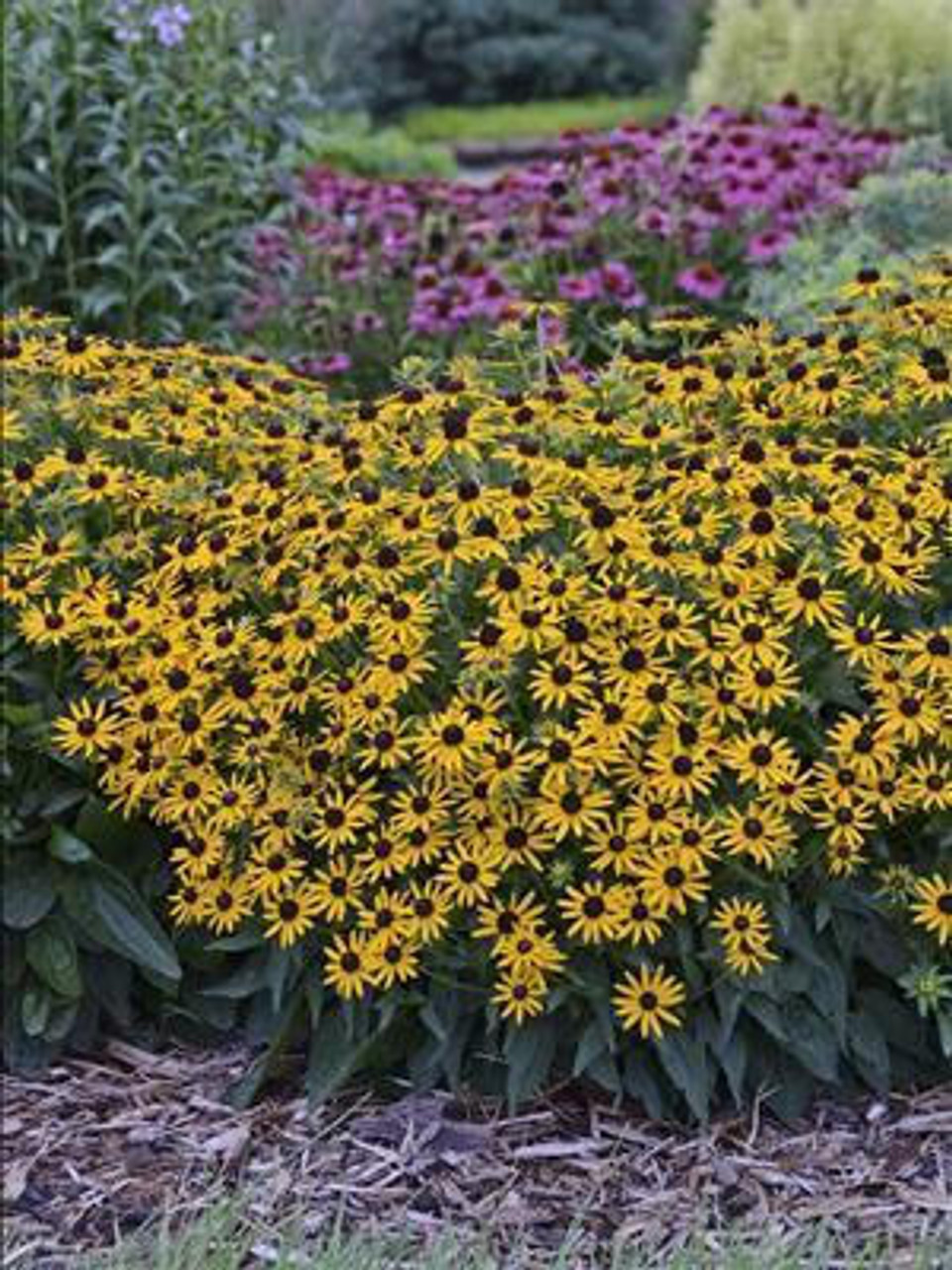Product Description
Rudbeckia fulgida var. sullivantii 'Little Goldstar' PP22397 (10)ct Quarts
Common Name: Black-Eyed Susan, Coneflower.
Zones 4 to 10, Sun, tolerates some light shade.
Plants reach 14 to 16 inches tall and 14 to 16 inches wide;
Growth rate: Moderate; easy to grow herbaceous perennial spreads by rhizomes and self-seeding (seed plants may not be as compact).
- More compact, proportional, and floriferous compared to 'Goldsturm'
- Starburst-shaped, 2-2½ inch, golden yellow blossoms from midsummer thru early fall
Bushy, short clump of rich green foliage is covered with a dome of closely spaced, starburst-shaped, 2-to-2.5-inch, golden yellow blossoms held just above the foliage. Very well-branched scapes carry loads of flowers from midsummer through early fall. Over 80 flowers have been counted on a single plant, making this selection more floriferous, as well as more compact than 'Goldsturm'.
Rudbeckia fulgida var. sullivantii 'Little Goldstar' is a compact and floriferous variety of Black-eyed Susan that brings a burst of sunshine to gardens with its cheerful golden blooms. Here is what makes this little gem shine:
- Abundant Blooms: 'Little Goldstar' lives up to its name by producing a profusion of bright golden-yellow, daisy-like flowers with dark brown center cones. These cheerful blooms appear from mid-summer to early fall, creating a long-lasting display of color.
- Compact Size: This variety is more compact than many other Black-eyed Susans, typically growing 14-16 inches tall and wide. This makes it a versatile choice for smaller gardens, borders, and containers.
- Attractive Foliage: The dark green foliage forms a neat, bushy mound that provides an excellent backdrop for the vibrant flowers.
- Pollinator-Friendly: The flowers attract a wide range of pollinators, including bees, butterflies, and other beneficial insects, contributing to 1 a healthy garden ecosystem.
- Easy Care: 'Little Goldstar' is known for its low-maintenance nature and adaptability, making it a great choice for gardeners of all levels.
Growing Tips:
- Sunlight: Plant in full sun (at least 6 hours per day) for optimal flowering. It can tolerate some light shade, but the bloom may be reduced.
- Soil: Prefers well-drained soil but is adaptable to various soil types, including clay and dry soils.
- Water: Water regularly, especially during hot, dry periods, but avoid overwatering. Once established, it has good drought tolerance.
- Hardiness: 'Little Goldstar' is hardy in USDA zones 3-9, making it suitable for a wide range of climates.
- Maintenance: Deadhead spent flowers to encourage continuous blooming. You can also divide the clumps every few years to maintain vigor and prevent overcrowding.
Design Ideas:
- Borders: Plant in groups or drifts to create a bold splash of color in borders and flower beds.
- Containers: Its compact size makes it well-suited for container gardening, adding a cheerful touch to patios and decks.
- Meadow Gardens: Combine with other native wildflowers and grasses for a naturalized look.
- Cut Flowers: The long-lasting blooms make excellent cut flowers for bouquets.
Ten (10) plants in quart containers per flat (or tray).
Other Details
The most important part of the plant is its root system. Healthy roots are the foundation of a healthy, vibrant plant. The type of plug container used is based on the specific needs of the plants. Perennials offered as bare root traditionally perform better when planted as bare root.Planted in a specialized mix, potted plants have well established root systems. Top growth stage will vary depending on the current life cycle and time of year when shipped. In Winter and early Spring dormant plants may be shipped. Dormant plants may be planted right away, even before the last frost date.
Most bare root varieties are field grown for at least one season, though Hemerocallis and Hosta are grown for two seasons. The bulk of the soil is removed during the harvesting process and the tops of most varieties are trimmed back to the crown. They are graded, packed in shredded aspen or sphagnum moss and stored in freezers until ready to be shipped.
See our Container Sizes and Bare Root Perennials pages for more information.
Plant information and care is provided in the Overview section, Plant Genus Page and general information is provided in the Planting Care & Guides. Additional questions can be asked on each Plant page.
Plant Spacing: Using the maximum mature spread or width of a plant to guide spacing, ensures space to grow to full size. To fill an area sooner, plant them closer together. Just remember, future thinning or transplanting may be needed.
Water: Keep a close eye on newly planted perennials, especially throughout the first growing year. Most early plant loss is due to too much or too little water!











